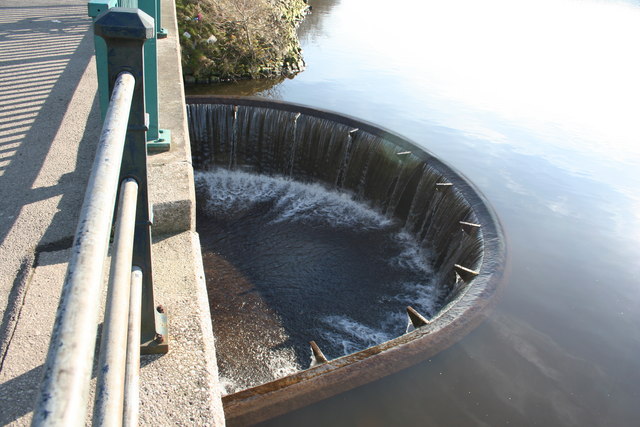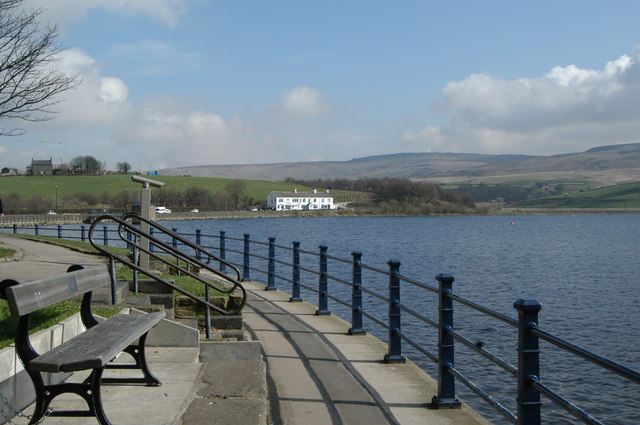Hollingworth Lake is a 130-acre (53 ha) reservoir at Smithy Bridge, in Littleborough near Rochdale, in Greater Manchester, England. The lake was built as the main water source for the Rochdale Canal, and became a tourist destination in the 1860s when it became known as the Weighver’s Seaport. Hotels were built around its shores, at least two of which had outdoor dancing stages with gas lighting. The arrival of the railway in 1839, had brought day-trippers and weekend visitors from Manchester, Bradford and Leeds, but the lake’s popularity declined in the early 20th century.
The surrounding area was used as an army camp during the First World War. The canal company sold the reservoir to Oldham and Rochdale Corporations for water supply in 1923 when the canal was in decline. After the Second World War, boating rights were bought by Rochdale Council, who developed the area into the Hollingworth Lake Country Park in 1974. The lake is home to the Hollingworth Lake Rowing Club, which has been in continuous existence since 1872.
History
In 1794 an Act of Parliament that sanctioned the construction of the Rochdale Canal was piloted through Parliament by William Jessop.[1] Hollingworth Lake, an impounding reservoir, the main feeder for the canal, was completed in 1800, four years before the canal opened. The site was not a natural hollow and three large earth embankments were built to enclose it. The main embankment, Hollingworth Bank, is 36 feet (11 m) high and 220 yards (201 m) long. Fens Bank is 30 ft high and 220 yards long and Shaw Moss Bank is 26 feet (8 m) high and 140 yards (128 m) long.[1][2] The lake, which drowned Hollingworth, an old hamletRural settlement smaller than a village., is about 557 feet (170 m) above sea level and covers 130 acres (53 ha). In places the lake was 25 feet (8 m) deep with an average depth of about 10 feet (3 m) . When constructed, it held 400 million gallons of water, about 1.8 billion litres.[3] A steam engine was installed to lift water 45 feet (14 m) into a four-foot (1.2 m) channel that fed into the canal’s summit pound at Chelburn.[1] The pumping engine was demolished in about 1910.[2]
Local mill owners, fearing the canal would diminish the water supply that powered their mills, defeated two attempts to obtain an Act authorising its construction. The Act passed at the third attempt after the canal company alleviated the millowners’ concerns, but it contained conditions regarding the reservoirs, so they did not interfere with water to the River Roch, Irk and Medlock.[4] Known as The Lodge when built, it supplied water to mills close to the canal and along the low-level road from Todmorden to Littleborough. The Lodge became known as The Lake, and became popular with walkers.[5]
The Rochdale Canal was in serious decline by the 1920s, and the Oldham and Rochdale Corporations Water Act authorised the councils to buy Hollingworth Lake and seven other reservoirs in 1923.[1] The canal company received £396,667, from which it paid £98,334 to the Manchester Ship Canal Company to compensate for the loss of water supplied by the canal company.[6]
A £2.5 million project to strengthen and reshape the earth dams was carried out in 1985. The outlet from the reservoir was rebuilt, and the level of the overflow was reduced. The lake was closed for leisure activities for almost a year.[1][3] A ten-year statutory inspection in 2011 identified the need to improve the outflow arrangement so that water levels could be lowered more quickly in an emergency or after heavy rainfall. The £1.25 million project included an {{convert|18|ft|adj=on} concrete tower, but the Friends of Hollingworth Lake and local councillors objected and it was reduced in size and clad in stone to fit in with the surroundings. The four-month project began in late 2011, and the water level was reduced by 6.6 feet (2.0 m) while the work was in progress, but the lake remained open for recreation.[7] United Utilities is responsible for the maintenance of the reservoir, the main function of which is to supply water to the Rochdale Canal; it has never been used to provide drinking water.[8]
Weighvers Seaport
The Manchester and Leeds Railway arrived in Littleborough in 1839, and was connected to towns in Yorkshire when Summit Tunnel was completed in 1841. In the 1850s Henry Newall, owner of Harehill Woollen Mill and his engineer Mr Sladen saw the lake as a tourist attraction, and leased it from the canal company, creating novelty amusements and facilities for boating. Small rowing boats became popular, and two paddle steamers operated on the lake from 1856. A rowing club opened by 1860 and a regatta was held in 1862. The Beach Hotel and the Lake Hotel and Gardens opened to cater for day trippers and weekend visitors. Excursions were advertised by the railway companies and visitors arrived at Smithybridge and Littleborough stations for the short walk to the lake.[9]
The lake became known as the Weighver’s Seaport; Davenport’s “Guide to Hollingworth Lake”, published from 1860 onwards, extolled its virtues in typical Victorian fashion:
The Fisherman’s Inn at Littleborough and the Blue Ball at Smithy Bridge were the only public houses but the Beach Hotel was built with accommodation, refreshment rooms and outdoor platforms illuminated by gaslight for picnic parties and dancing. The Lake Hotel and Pleasure Grounds, to which visitors could walk, travel by carriage or cross the lake by steamer, was built in the Swiss style on the opposite side of the lake.The booking office at the ferry terminal was connected to the hotel by a “Subaqueous Telegraph cable”, laid on the lake bed.[11]
In November 1865 Mr Newhall was notified of “the immoralities which it is stated take place in connection with the dancing stages at Hollingworth.” Two months later he replied that if such immoralities were taking place, they were certainly not doing so on any part of the reservoir or land which he was leasing from the canal company.[12]
At the height of its popularity in the late 19th century, visitors arrived by trains from Manchester, Leeds and Bradford, and three lake steamers ferried them across the lake. Fishing developed after 30,000 fish, mostly bream, dace and perch, were introduced in 1863. Stalls and lock-up shops close to the ferry landing stage traded in sweets, snacks and souvenirs, and on special holidays, there were fortune tellers, conjurers and tricksters. Six photographers listed in Davenport’s Guide took portraits of visitors. A roundabout with galloping horses, powered successively by a hand winch, a steam engine, a gas engine and electricity, remained at the lake until after the Second World War.[13] The lake froze in 1860 and 1864, when more than 2,000 people skated on the ice. Teams from Leeds, Liverpool and Manchester played in curling matches, and local teams played cricket. Cricket was played in 1871, and in the 20th century the lake froze in 1902, 1907, 1924, 1929, 1941 and 1947. The lake almost dried up in 1934, when the water level dropped so low that stone farm buildings which had not been seen since 1800 became visible.[14]
Decline
By the beginning of the 20th century, the lake’s attraction was diminishing. The stunts and shows stopped and by the start of the First World War the lake was in decline. There was an upsurge in activity when a training camp for the Manchester Regiment was set up in the Ealees Valley and the hotels and local houses accommodated wives and visitors. Most soldiers from the camp were sent to the Dardanelles. After the war, the rowing club developed and the lake was used for sailing. Day visitors could hire rowing or motor boats, but only the Fisherman’s Inn and the Beach Hotel remained open.[15]
Revival and country park
In 1950 the boating rights which had been held by the Water Board since 1923 were taken over by Rochdale Council. The council turned the area into a country park in 1974. Ten years later, it was in a list of the top ten country parks in England.[3] The lake is used for recreation, and the country park includes a wildlife sanctuary. The Beach Hotel and the Wine Press, formerly the Fisherman’s Inn, survive.
The lake supports watersports such as sailing, windsurfing, canoeing, swimming, rafting, rowing and fishing. Since 1989 Hollingworth Lake Water Activity Centre has offered tuition in kayaking, canoeing, power boating and sailing. In summer, visitors can hire rowing boats. The centre operated a 34-foot launch, The Lady Alice,at weekends during the summer months for trips around the lake until 2009.[16] A new pleasure boat, The Lady Katherine was launched in May 2019.[17] The scenic walk, 2.5 miles (4.0 km) around the lake, passes a nature reserve and bird hide in the south-western corner, from where boats and watersports are excluded.





